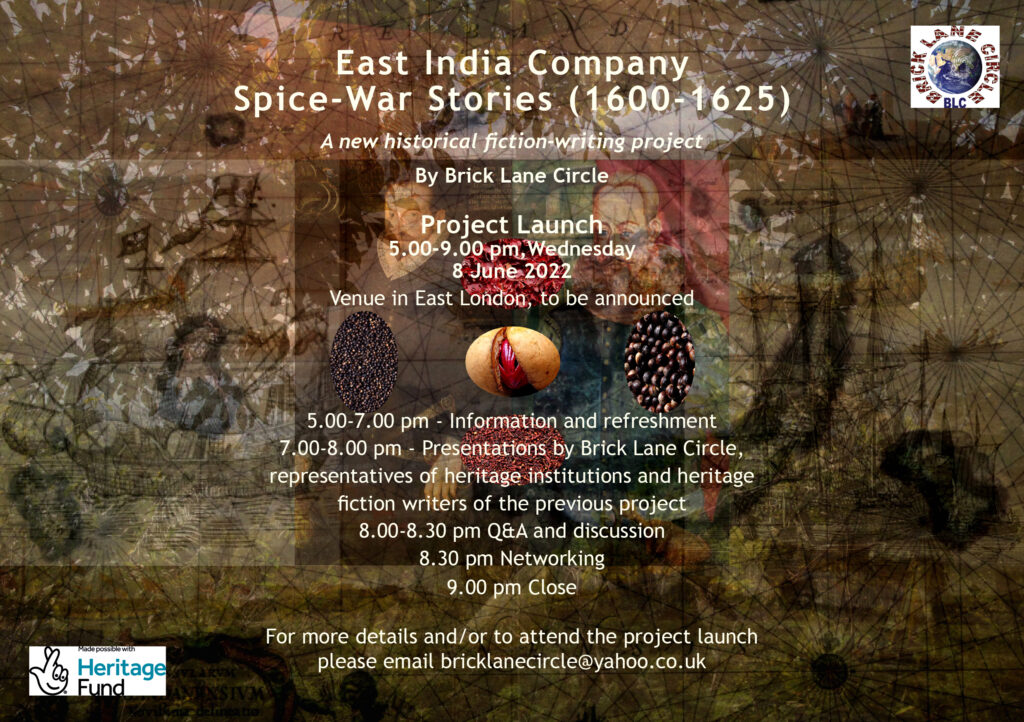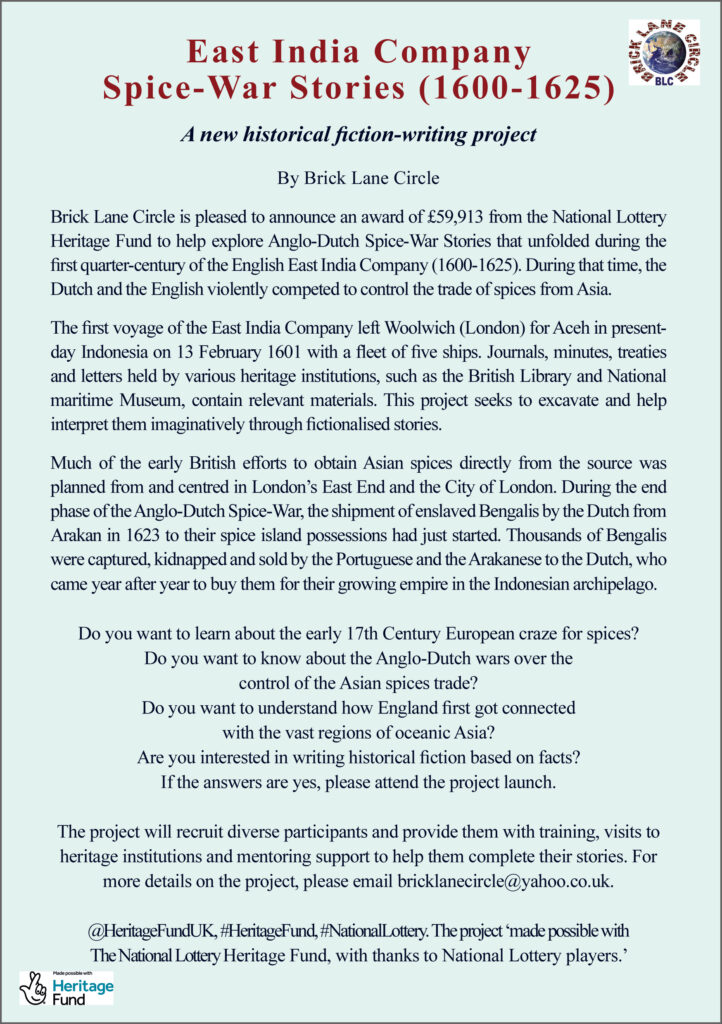

For more details please email bricklanecircle@yahoo.co.uk
Press Release!
Brick Lane Circle is pleased to announce an award of £59,913 from the National Lottery Heritage Fund to help explore Anglo-Dutch Spice-War Stories that unfolded during the first quarter-century of the existence of the English East India Company (1600-1625). During that time, these two powers competed violently against each other to control spices from Asia. Journals, treaties and letters at various heritage institutions, such as the British Library, London Metropolitan Archives and Royal Museum Greenwich, contain relevant materials. This project seeks to help interpret them imaginatively through fictionalised stories.
The project will engage diverse participants from East London with a particular focus on the local Bangladeshi community as they have strong historical and recent connections with the British history of love for spices. The participants will:
- Become familiar with encounters, events, activities, dangers, violence, brutality, profits and sea voyages associated with the competitions for spices
- Interact with heritage resources and help bring to life, through creative imagination, stories of the past and share them widely
- Develop an understanding of how various locations in East London and the City of London got connected with places across the vast landmasses and waters of Asia, east of the Cape of Good Hope.
Through this process, we aim to help promote greater levels of engagement with our common inter-linked heritage going back to many centuries when the process of connecting began with competitions for spices. It will, hopefully, inspire others to take the love and learning of heritage further, deeper and wider, utilising ever-more creative methods.
Much of the early British history of spices was planned from and centred in London’s East End and the City of London. During the end phase of the Anglo-Dutch Spice-War, the shipment of enslaved Bengalis by the Dutch from Arakan in 1623 to their spice island possessions had just started. Thousands of Bengalis were captured, kidnapped and sold by the Portuguese and the Arakanese to the Dutch, who came year after year to buy them for their growing empire in the Indonesian archipelago.
The four-hundredth anniversaries in 2020 and 2023 – the Dutch capture of the only English possessed nutmeg island, Pulau Run, in October 1620, and the massacre of the English by the Dutch in Ambon in March 1623 – provide a unique opportunity to generate broad interest in the early English history with the worlds of diverse Asia. Materials held at heritage institutions provide relevant records that can be utilised to explore and write about many topics, from occurrences in the Atlantic to Asia, including what happened on land and at sea.
During the days of the empire, many in Britain were somewhat familiar with the spice history and European colonialism. But today, very few people know much about that and what little they do know are from colonial perspectives. Moreover, some of the past stories that have come down the generations were from certain perspectives – English-centric, British-centric or Euro-centric – unsuitable for a modern diverse multi-cultural Britain. As such, this project, in effect, will help contribute towards a re-examination of heritage materials stored at British heritage institutions and help develop fresh interpretations through critical reading and creative imagination.
The East End has also become known, at least from the post-war period, as a centre of curry and a place to taste the delicious spices of Asia. Although the Bangladeshis, Indians and Pakistanis were the ones that set up the East End curry houses, the Bangladeshis have come to dominate the scene with a continuous presence. British curry has also become somewhat synonymous with the Bangladeshi community as they have set up curry restaurants in every corner of the country, spreading the taste of Asian spices across Britain.
The participants and the wider community will understand how the East End and the City of London got directly connected to Asia through the incredible efforts to secure the most sought-after spices from the sources. They will also learn how that involved taking enslaved Bengalis by the Dutch to work on their newly established nutmeg plantations from 1623 onward. This knowledge will enable more people to develop a better appreciation of East London’s and the local Bangladeshi community’s links with the early 17th Century European craving for spices and help generate new perspectives on the heritage of the East End.
This incredible initiative will also enable more people to become aware of what East London looked like around four hundred years ago. For example, the industries and jobs in the area, shipbuilding, timber usages and sailing ships utilising wind power. Knowledge of the past in this regard will enable our diverse communities to develop greater levels of awareness of environmental issues concerning our modern-day carbon usage, sustainability and living conditions.
The project will produce a printed stories book, an exhibition, a video documentary; engage additional ten participants to deliver a drama performance. In addition, there will be a project completion celebration and touring events.
Brick Lane Circle will provide more details on the initiative in due course and organise promotional events to attract broad interest and explain how individuals can get involved with the project. For further details, please email bricklanecircle@yahoo.co.uk.
Some examples of stories from the records
The English’ East India Company’, founded in 1600, launched its first voyage to Asia from Woolwich in February 1601 with five ships. During the thirty-one month journey to Asia and back, the fleet experienced many ordinary, extraordinary and incredible encounters, incidents and occurrences. They include pirating Portuguese ships; facing deadly storms at sea; signing trade treaties; establishing a factory (trading settlement); engaging in trade; experiencing the deaths of hundreds of seamen from scurvy and dysentery; the perishing of two captains, one from friendly fire and the other from the dreaded blood flux.
The next voyage left London in 1604 and visited Banten, Ambon, Ternate, Tidore and the Banda nutmeg islands. Encounters include Captain Henry Middleton saving the life of the king of Ternate by firing cannons from his ship and picking up the king from the waters, where he was being chased by the forces of the king of Tidore (a neighbouring island with a long historical feud). The third left London in 1607 for Surat in India, where Captain William Hawkins was dropped off in 1608 to travel to the court of the Moguls to obtain permission for trade from Emperor Jahangir. His account of the journey to and more than two years stay at the Moghul court are fascinating, with many remarkable stories of jealousy, murder, fear of death, a semi-forced marriage, betrayal, castration, and so on.
On the way from England, some records report the performance of Shakespeare’s ‘Hamlet’ on board the flagship ‘Red Dragon’ in 1607, when anchored on the shores of Sierra Leone due to being stuck in the mid-Atlantic Doldrums and the need for restocking supplies.
The fourth voyage, which left London in 1608, was a total disaster, where both the two ships were lost, one near Gujarat and the other on the way back to England near France. Those who survived the wreck near Gujarat managed to get to the shore but could not land in the main port as it was under the strong influence of the Portuguese, who were trying to prevent the English from having a foothold in India. So, instead, they landed in a nearby place from where they split into two groups. One travelled by road to Agra and met up with Captain William Hawkins, while the other, much smaller in number, made its way to the Coromandel coast by road and then by sea to Banten. This voyage also witnessed the first English East India Company conflict deaths in islands on the eastern side of the African continent, in Pemba and Madagascar.
The accounts of these voyages are fascinating and have an incredible quantity and variety of materials for imaginative interpretations through fiction.
There are also many remarkable stories from other voyages, including the twelfth, one of whose main missions was to transport the Persian Ambassador to England, his wife and his entourage back to Persia. Interestingly, the Persian ambassador was an Englishman who had married a Persian lady during his previous travels to Persia. But unfortunately, the plan did not go smoothly. According to East India Company records, the ambassador was nearly killed by a Baloch governor in Gwadar, situated in present-day Pakistan, through a deceitful plot. But the East India Company commander came to know of this from an Indian Muslim scholar and saved his life by devising and executing an ingenious plan.
In 1616, some English East India Company officers with two ships established a base on the famous island of Pulau Run in the Banda Archipelago, the only island still free from Dutch control. There followed a four-year-long Dutch siege around the small territory. It ended with the killing of the East India Company settlement leader, Nathaniel Courthope, in October 1620, during a night ambush at sea.
After that episode, the whole nutmeg island archipelago came under the control and monopoly of the Dutch. A few months later, in 1621, the infamous Banda massacre took place, where the Dutch nearly wiped out the entire native population of the Banda Islands. Two years after that, the notorious Amboyna Massacre took place in Ambon, where the Dutch tortured and killed more than a dozen people, including ten Englishmen.
It was also when the Dutch imported many enslaved people into their growing empire in the Indonesian archipelago, including men, women and children from Bengal, who were captured and sold by the Portuguese and the Arakanese. From then onwards, the English East India Company started to refocus its attention, and the Indian subcontinent became its main target for trade.
During these voyages, the Company ships visited Gran Canaria, Cape Verde Islands, St Helena, Saldanha Bay, Madagascar, Comoro Islands, Zanzibar, Pemba, Socotra, Aden, Mocha, Iran, Surat, several places on the Coromandel coast, Sumatra, Java, Maluku, Sulawesi, Borneo, Pattani, Ayutthaya, Japan and many other places. The voyages experienced deaths from disease and shipwrecks; established trade treaties and factories; carried out piracies and fought sea battles; executed people for homosexuality and murder onboard ships; undertook land travels to the court of the Moghuls from Surat and from Surat to Masulipatnam.
Note to editors
About The National Lottery Heritage Fund
Using money raised by the National Lottery, we Inspire, lead and resource the UK’s heritage to create positive and lasting change for people and communities, now and in the future. www.heritagefund.org.uk.
@HeritageFundUK, #HeritageFund, #NationalLottery. The project ‘made possible with The National Lottery Heritage Fund, with thanks to National Lottery players.’
